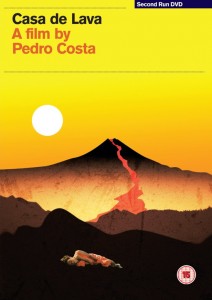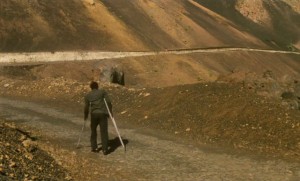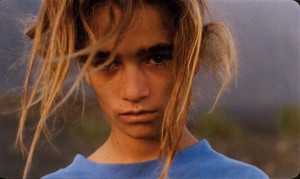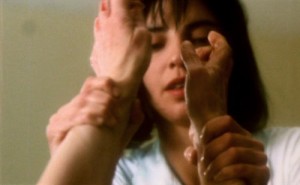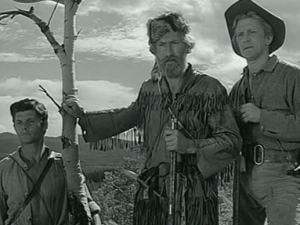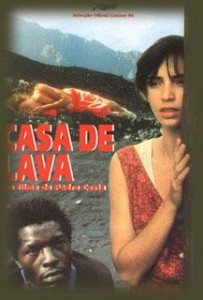Written for the Second Run DVD of Pedro Costa’s Casa de Lava, released in the U.K. in 2012, and developed from separate articles in the Chicago Reader, November 15, 2007, and the Portuguese collection cem mil cigarros: OS FILMES DE PEDRO COSTA, edited by Ricardo Matos Cabo, Lisboa: Orfeu Negro, 2009. — J.R.
The cinema of Pedro Costa is populated not so much by characters in the literary sense as by raw, human essences — souls, if you will. This is a trait he shares with other masters of portraiture, including Robert Bresson, Charlie Chaplin, Jacques Demy, Alexander Dovzhenko, Carl Dreyer, Kenji Mizoguchi, Yasujiro Ozu, and Jacques Tourneur. It’s not a religious predilection but rather a humanist, spiritual, and aesthetic tendency. What carries these mysterious souls, and us along with them, isn’t stories — though untold or partially told stories pervade all of Costa’s features. It’s fully realized moments, secular epiphanies.
Born in Lisbon in 1959, Costa grew up, by his own account, without much of a family. Speaking about O sangue, his first feature, he admitted that there was a personal aspect in his concentration on the incomplete family in that film “because I never really had a family. My mother died early, then I went to live with my father, who then went away. From the age of 14, I was alone…” Perhaps for this reason, family life — actual or simulated — is central to his work, just as untold or partially told stories hover over his secular, nonnarrative epiphanies. And maybe the lack of fully articulated stories has something to do with the lack of fully articulated families. So one could say that the passionate struggle of outsiders to find and maintain makeshift families as well as workable narratives provides much of the meaning as well as the methodology of his work. It also surely accounts in part for the trancelike mantra, derived from a Robert Desnos poem, that recurs in his work, starting with Casa de Lava, as if it were trying to conjure up a spell: “I wish I could offer you 100,000 cigarettes, a dozen fancy new dresses, a car, the little lava house you always dreamed of, and a 40 cent bouquet…” 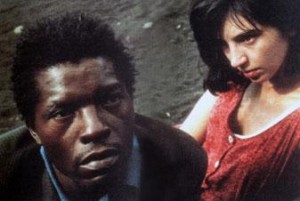
Existentially speaking, if one combines this struggle with Costa’s uncanny and always evolving talent for composition and color, the overall aspiration resembles both what Godard has called “the definitive by chance” and the fusion of fiction and documentary sought and found by Kiarostami (especially in Life and Nothing More, Through the Olive Trees, and The Wind Will Carry Us, whose plots also feature strained interactions between big-city protagonists and the impoverished yet exotic villagers they’re visiting). It also suggests that Casa de Lava may be the film of Costa’s that poses the most constant and furious tug of war in his oeuvre between Hollywood narrative and the portraiture of both places and people, staging an almost epic battle between the two. These warring modes become almost magically fused whenever there is a landscape shot with one or more human figures; every time this happens, the film moves into high gear. (In November 2008, in a park in Lisbon, I asked Costa at one point why he hadn’t made any more landscape films. “It’s too easy,” he said.)
It was Casa de Lava, of course, shot in Cape Verde, that led Costa to Fontainhas, the focus of most of his subsequent features to date (first as a location and then, thanks to “urban renewal,” as a bittersweet, nostalgic memory). As he said to Patrick McGavin in an interview, “Without Casa de Lava, there’d be no other films. It was the film that gave me the direction. They gave me the addresses and they just told me they’d never see me again. They’d say, ‘Take this message to my mother. Take this package of tobacco to my father.’ They are all immigrants in this place. That’s how I found Fontainhas. You’d probably never go there. It’s almost a destiny, the key to the other films.” 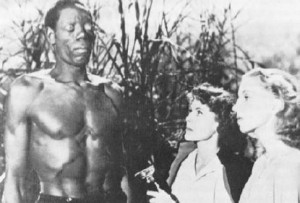
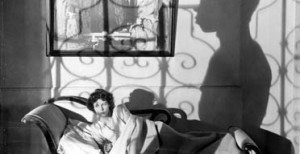
But to complicate matters, Casa de Lava — Costa’s second feature and his first in color, its title stupidly translated in the U.S. as Down to Earth — is also a voluptuous “remake” of Jacques Tourneur’s 1943 film I Walked with a Zombie. The supposed zombie here is Isaach de Bankolé, playing a construction worker in a protracted coma. Some people, unlike me, feel that as a reference point, I Walked with a Zombie provides an obstacle or distraction when it comes to appreciating Casa de Lava rather than a useful key that unlocks some of the film’s treasures. Others feel that Stromboli is a more helpful reference point, whereas for me it is the Rossellini film, with its very different and less politicized form of mysticism, that provides a distraction and an obstacle, whatever its own merits. Casa de Lava, by contrast, poses the unanswerable question of how one can honorably or usefully behave inside a charnel house, a former slave colony.
Interestingly enough, a shotgun marriage of Straub-Huillet’s materialism with Jacques Tourneur’s spectral ghostliness comprises Costa’s two key methods of posing his dilemma, staged in a contradictory yet dialectical showdown. It’s worth adding that Jean-Marie Straub and the late Danièle Huillet’s appreciations of Chaplin, Ford, Hawks, Lang, and other commercial auteurs anticipate the fact that Colossal Youth (2006) was viewed by Costa as a remake of Ford’s theatrically lit Sergeant Rutledge (1960), with the traumatized Cape Verdean patriarch Ventura standing in for Woody Strode, while Tarrafal (2007) for him was a remake of Tourneur’s Night of the Demon. More generally, one could argue that Costa shares with Straub and the late Huillet a critical appreciation and understanding of cinema that have not, for the most part, been supported by any writing. In Costa’s case, the best illustration of this critical intelligence is a series of lectures that he gave in Tokyo in 2004, reproduced as a single text in English (“A Closed Door That Leaves Us Guessing”) in the online magazine Rouge. (www.rouge.com.au/10/costa_seminar.html)
Casa de Lava begins with some (arguably misleading and somewhat misplaced) silent footage of volcanic eruptions, followed by stark island portraits — the latter evocative of films by both Straub-Huillet (their fiery Etna and their German or Italian actors, sometimes glimpsed from behind or in fragmented body parts) and Dovzhenko (brooding and toweringly heroic still-lifes) — only to shift from there to the shards of a Lisbon narrative. Typically, in the latter stretches, we’re either told too little about what’s happening in order to be able to follow the story or everything we could possibly want to know — in both cases in a rather mannerist fashion. First we get quizzical fragments and a very oblique narrative, served up almost as directly as the island portraits were — the sounds and images of a Lisbon construction site, anticipating Costa’s Fontainhas films, and then Leao and other construction workers, seen before Leao’s accident — including a bit of seemingly choreographed, playful sparring between two of them as they hustle through a doorway, returning to work — and just afterwards as well. (The accident itself is elided, but we glimpse a coworker reporting it.) Then, shortly after we’re introduced to Mariana (Inês de Madeiros, also the female lead of O Sangue), a nurse, with a coworker at the hospital, we get enormous chunks of exposition from a doctor speaking to Mariana over Leao’s body, dumped unceremoniously into our laps and delivered swiftly, this time evoking (at least in its staccato pacing) the much earlier Straub-Huillet of Nicht Versöhnt (1965), and concluding, “They say he was sad. His name is Leao. He’s been two months in a coma. Oddly, he’s been discharged. The ticket’s bought. Leao’s going home. A check and a letter from his village, both anonymous. A woman’s letter. What a shame.”
Much later in the film, the son (Pedro Hestnes) of a white islander, Edite (Edith Scob), gives a similarly telegraphic account of his mother, himself, and the allotment of funds, again to Mariana, over his father’s grave: “She came after him. She was 20 years old. She was half his age. I never met him. He was a political prisoner. Afterwards, she never went home. She’s been here for years with me. People help her. She likes them, they like her. We live here. Now we get a check every month, his pension, to pay everyone back. They know, they all wait. They all want to leave.” Once again, as if to illustrate Costa’s discomfort with narrative exposition, we get too much information instead of too little, crammed into the smallest possible space. 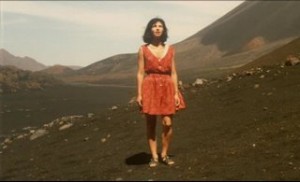
The film is a suite of denials from all the characters, one after the other. Leao’s coma might be considered the first and most important of these. Bassoé (Raul Andrade), a dazed and slightly crazed islander and violinist who anticipates Juventude en marca’s Ventura in some respects, and who plays the same plaintive tune on his violin as often as Ventura recites his mantra about 100,000 cigarettes, refuses to acknowledge directly that he’s the father of Leao, and other locals refuse to respond when Mariana asks them if Leao is a relative. But Mariana is no less in denial when people ask her directly or indirectly why she isn’t back in Lisbon. Edite’s son puts it the plainest: “Why are you here?” And, like Bassoé, she never answers the question of whom she belongs to and who belongs to her. 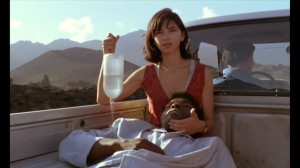
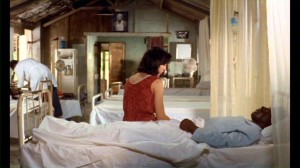
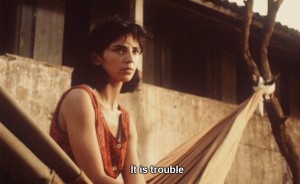
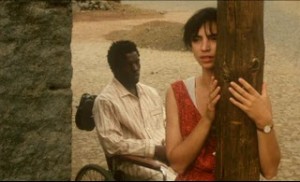
Worst of all, she can’t seem to “go native” as Edite, her doppelgänger, does, maybe because her own self-appointed function on the island is merely to be the caregiver of Leao, who has no clear place of his own on the island, and who can’t even figure out what her exact function is even after he wakes up. Maybe she likes boys, as she puts it to Edite’s son, but unlike Edite, who likes girls as well as boys, she’s pretty much in denial about her sexuality whenever it has to rub shoulders with any sort of emotional commitment. The only emotional commitment she seems to have is to Leao, and this has nothing to do with Hawksian professionalism. In fact, there are no professionals in this movie apart from the soldiers, who never come back from whatever war they’re servicing, or the doctor in the medical compound, who seems to evaporate about halfway through the picture, or Edite, at least if she qualifies as a professional colonialist. The other characters, so far as we can tell, are all lost children — thus qualifying them as full-fledged citizens of Costa’s world but not as players in any wider universe.
There are at least four other Andrades listed in the cast, all of them playing children of Bassoé — one of many factors that suggests that the film, like all of Costa’s other films, is an intricate mixture of fact and fiction. Costa told Mark Peranson in Cinema Scope (issue no. 22) that the film was originally scripted, but “at one point I just left the script behind, because I thought that if I’m going to try to shoot this girl in this new place that’s foreign and dangerous, then I have to shoot it from her point of view,” and “There was a lot of improvisation each day” — one indication among many that Mariana largely functions as Costa’s surrogate in the film. Nearly all the ethical questions and ambiguities posed about her involvement with the islands’ residents are those raised by Costa’s involvement — that is to say, by his filmmaking — as well. And improvisation is perhaps the most obvious way of raising the existential stakes of these issues. As Costa notes, he and Isaach De Bankolé even came to blows over the latter’s objections as a professional actor to his character Leao having to remain in a coma for most or all of the film. It’s also my impression — gleaned from the account of a friend who attended Costa’s discussion of the film in Los Angeles — that Leao, like his rough counterpart in I Walked with a Zombie, never would have come out of his coma at all if it hadn’t been for Bankolé’s strenuous objections.
Leao regains consciousness almost exactly halfway through the movie, although it takes Mariana much longer than that to become aware of his awakening. Even some of the other lost children, such as Tina, know it sooner. And once Leao re-enters the land of the living, we don’t feel that any of the film’s basic conundrums get solved.
It would be interesting to know what Costa’s original scenario would have consisted of if Leao had remained in a coma for the remainder of the movie. As things stand, and no doubt because of the improvisation, the film breaks up and gradually atrophies into fragments and miniplots, a little bit like Muriel or Petulia. But, come to think of it, I Walked with a Zombie also winds up subverting the very notion of a consecutive, coherent plot. Here one could almost say that each beautiful composition — that is to say, each shot — tells a separate story. Put them all together and they might seem to resemble the lengthy tracking shot that follows Mariana’s stride through the village, at once purposeful and aimless, as various obstructions pass and periodically block our vision. Now we see her, now we don’t — and neither we nor she seems to know where she’s headed.
Whoever or whatever else Leao might be, conscious or unconscious, he isn’t a zombie, much less Tourneur’s more mythical and statuesque zombie Carrefour. As far as we can tell, he’s an illiterate Cape Verdean construction worker in Lisbon who has an accident, winds up in a coma, and then, after being taken back to Cape Verde, takes his time coming out of it because even if he has a home to come back to, everyone else is leaving there and no one wants to stay — except, perhaps, for Mariana (if only by default) and Edite and her son. And at least the latter two speak Creole.
Whenever Mariana repeats the phrase, “Speak Portuguese,” to someone on the island, I’m reminded of Arthur Hunnicutt’s Zeb Calloway in Hawks’ The Big Sky trying to relate to his French partners as they trek across the wilderness: “Speak English, hoss.” But Mariana has no partners, and consciously or not, she remains a colonialist, perhaps even more than Edite and her son are colonialists, because she hardly gives anything to the islanders. And Costa can’t interrogate her motives for remaining on the island without interrogating his own. It’s not a question he can answer, but it’s the brutal posing of this dilemma that makes Casa de Lava, for me, his strongest film.
Can the film itself be regarded as his own patient? And if so, what can Costa do once the film wakes up on its own, without his help or input? Answer: The same thing we can do. He can watch.

